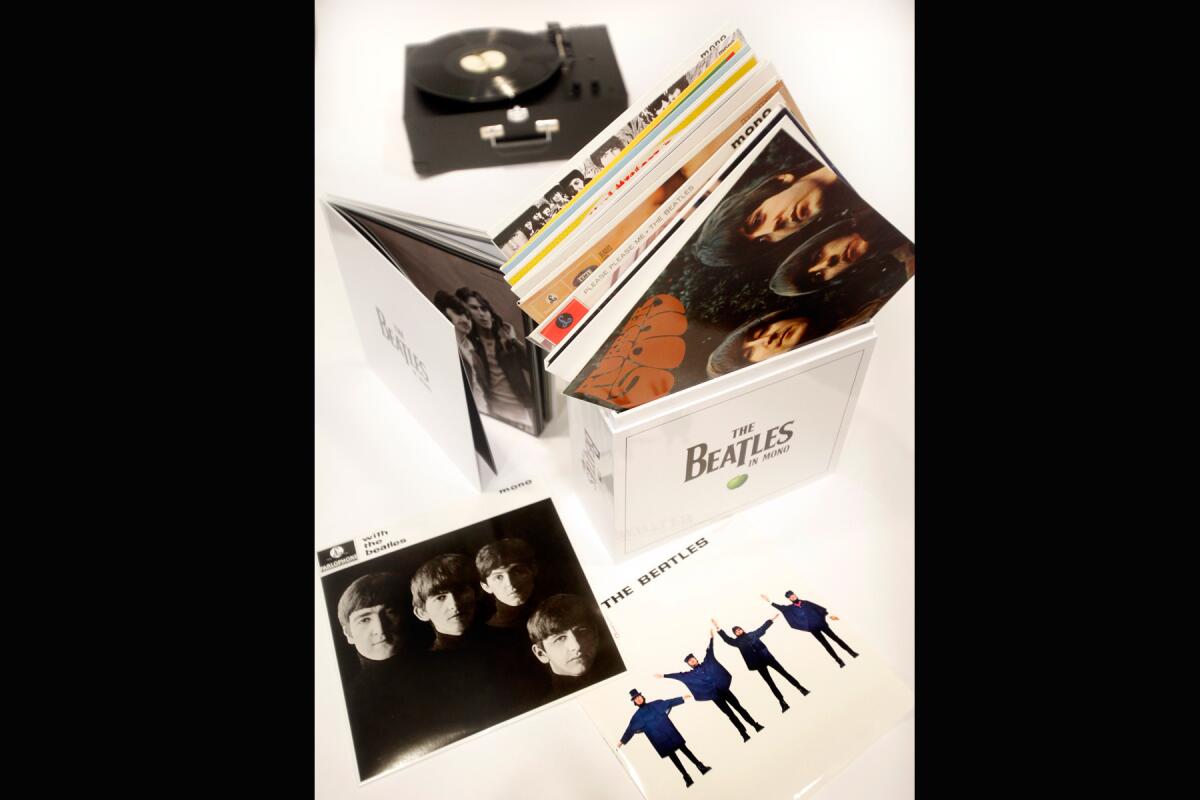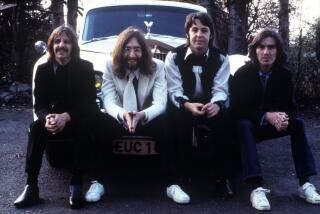Review: Is ‘The Beatles in Mono’ necessary? Yes and no.

One of the ironies of our collective obsession with the Beatles is that as years pass, as new anniversaries are noted, as their label embarks on yet another deluxe reissue campaign — this time for “The Beatles in Mono” LP box set — it’s getting harder and harder to hear their music.
We can listen on repeat all we want. Flip on the radio and “Hey Jude,” “Back in the U.S.S.R.” or “Yesterday” stands a good chance of rotating in. We can chase all the remasters, “Past Masters” and deluxe versions, follow the many marketing campaigns and seek out cover versions of the band’s songs from around the world. It’s everywhere, all the time.
But to actually absorb their often-miraculous compositions with fresh ears — listen hard and deep and minus those embedded expectations — is nearly impossible. Once you can recite every lyric, every ringing George Harrison lead in “Day Tripper,” anticipate each refrain in every song on “Rubber Soul,” hum Paul McCartney’s revelatory bass lines on “Help,” feeling genuine spine-tingling thrills with the Beatles is way, way tough.
That doesn’t mean we don’t crave it. We want to feel that thing again, and the label and the Beatles’ estates are happy to fuel that desire. That moment of “A Day in the Life” when noise gives way to piano? Amazing! We want to soak in “Rain,” experience with pure clarity the double guitar in “And Your Bird Can Sing.”
Long in the making, this new “Beatles in Mono” thing, out Tuesday, lists for about $400, weighs 18 pounds — the same as 80 iPod minis — and consists of the 10 titles that the band recorded as monaural, as opposed to stereo, albums (including the double “White Album”). An additional three-LP collection features extant mono recordings. (The Beatles’ last few records were released only in stereo.) This distinction is crucial to understanding the fetishization of these creations.
During the 1960s, stereo was gradually supplanting mono recording as the technology of choice, and the Beatles made records at the moment when preferences had yet to fix on stereo. Most aesthetes like Beatles producer George Martin preferred mono because stereo was considered gimmicky.
“It was a commercial demand that had to be fulfilled, ideally without compromising the mono version that everyone working on the recording really cared about,” writer and musician Damon Krukowski wrote in a fascinating essay on mono recording published recently by Pitchfork. Such was the case with the Beatles and Martin. They recorded for mono and adapted for stereo, and you can hear the difference.
Heard loudly — and properly — “Revolver” is not only a marvel of songcraft but also of production and engineering. Ditto earlier work. Drop the needle and bask in Harrison’s weird tremolo guitar on “I Need You.” Did you know that Ringo Starr played cowbell on “A Hard Day’s Night” or that the shuffle-rhythm of “Another Girl” was so propellant? Harrison’s strange country licks in “Another Girl” seem to shimmer. Absorb the depth of Ringo’s tom-tom drums, of John Lennon’s Rickenbacker strum on “Ticket to Ride.”
For the fetishist, each album is an exquisite, ever-caressable object: pressed on 180-gram vinyl and held within replicas of the originally issued, striking — and wonderfully durable — jackets. “The Beatles” — a.k.a. “The White Album” — arrives in a glossy gatefold sleeve, the band’s name crookedly embossed and possessing a unique numerical identifier, just like the first issue in 1968. It includes a portrait of each Beatle, as in the original, and comes with a replica paper inner sleeve.
To peruse “Magical Mystery Tour,” with its gatefold sleeve and full-color 24-page book, while preparing to hear “Strawberry Fields Forever” is like lighting a candle and some incense before a make-out session. The quality, the sense of import throughout the set, puts you in the mood for Eleanor, lovely Rita, sexy Sadie, dear Martha and/or Mr. Kite. In such a context, even the piggies, walruses and octopus wouldn’t seem half bad.
But is “The Beatles in Mono” necessary?
Not if you’re the kind of Beatles fan who until now didn’t know or care that there was a difference between the two versions of their records. Most who know sonics or obsess over the band already have original mono versions, relatively easy to buy on EBay. After all, the band sold a hell of a lot of records.
For this majority, appreciating the intricacies of “The Beatles in Mono” versus the Beatles on compact disc, used stereo vinyl or high-quality MP3 is akin to distinguishing between a $400 and a $200 bottle of Bordeaux.
Whether “The Beatles in Mono” is sonically superior as well depends on the quality of speaker system, amplifier, turntable, stylus, cartridge and speaker-wire gauge. At each of these points, the signal can be distorted or somehow diminished. The clarity of your signal throughout the chain is crucial to hearing this thing properly. Plan on playing it on a dinky Crosley or airport-bought earbuds? Don’t bother.
Call me gullible, but I found the collection oft revealing, and I was exposed to nooks and crannies lost or rendered muddy when compressed for FM radio broadcast or heard on those horrible first compact disc versions. On the proper gear and heard in an acoustically decent room or on noncrappy headphones, sounds pop and erupt from the mono albums with a force that suggests not just a hot band hitting its peak but a producer hitting his as well, both harnessing high-tech gear to great effect.
It all feels so true, so real. Is it illusion? The placebo effect? Am I hearing this differently because I’m supposed to? Am I tasting a hint of tobacco and vanilla in this because the snooty lady tells me so, or because I can actually sense those nuances?
It’s hard to tell. Honestly, there have been times when most everything transcendent about the Beatles has vanished beneath the weight of memorization. By the time the “Hey Jude” “na na na” refrain hits its fourth bar, I haven’t really needed — or even wanted — to hear the next 36. I know when Paul’s “Jude-Jude-Judy-Judy-Judy” tantrum is coming. It may be great, but it no longer triggers the dopamine like it once did.
More to Read
The biggest entertainment stories
Get our big stories about Hollywood, film, television, music, arts, culture and more right in your inbox as soon as they publish.
You may occasionally receive promotional content from the Los Angeles Times.











